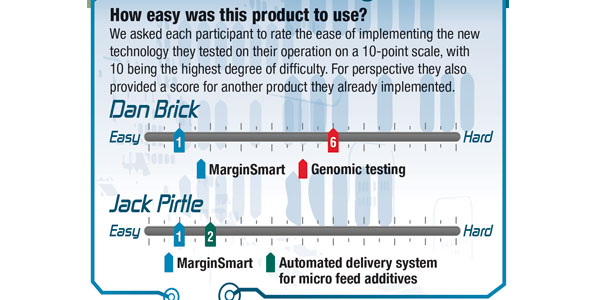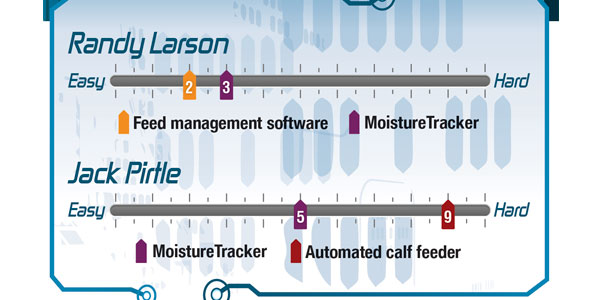Dairymen who test-drove one of three new technologies for free in 2014 discuss their decisions to keep the new products and begin paying for them or discontinue their use and return them in 2015.
These producers completed interviews about their experiences using the new products in exchange for their free use for a full year. Progressive Dairyman recently interviewed all of the producers to find out what factors influenced their final decisions.

MarginSmart
By Dairy Analyzer LLC
Both web-based margin projection software test-drivers say they are both going to keep the program and begin paying for it themselves in 2015. Dan Brick of Brickstead Dairy in Greenleaf, Wisconsin, and Jack Pirtle of P7 Dairy in Roswell, New Mexico, had one-year platinum licenses to MarginSmart from Wisconsin-based Dairy Analyzer LLC.
Brick and Pirtle agree that the software helped them dig deeper into their actual costs of production.
“It helped me stay on top of my margins all the time,” Brick says. “It also forced me to spend time weekly pulling my numbers together. It brought attention to my feed and labor costs.”
During the course of the year, neither dairyman felt the software’s margin projections were 100 percent accurate, but they both agreed they are accurate enough to use as a tool to make future decisions.
For Brick that meant forward contracting most of his feed and some milk prices in 2014. Going forward he will continue to use the program’s margin projections to advise his contracting strategies. Brick anticipates the predicted lower margins for milk in 2015 will make margin projecting all the more valuable.
“As I go into 2015, the biggest benefit of the product to my operation will be in contracting milk,” Brick says. “The margins are much tighter this year. Today it may be plus 50 cents, and tomorrow it may be minus 50 cents. When there were $5 or $6 margins in 2014, I wouldn’t have needed MarginSmart to know that was a good margin for me.”
Brick will account for the cost of the software as an expense of milk contracting. He says it takes about an hour per week to maintain the numbers in the software. In 2015, he will also continue to meet with Mark Linzmeier, the software’s creator and its technical service adviser, every three weeks. Their regular meetings throughout the trial period kept Brick committed to a thorough test of the program.
“I had an appointment with somebody and a deadline to get it done. Somebody was waiting for me to get numbers to him,” Brick says. “That obligation to him and to myself helped me stay on top of it.”
If Brick had one thing he could do over during the test drive, he’d have Linzmeier enter his expenses and contracts from the get-go. He still thinks the data entry is simple enough he could do it himself, but he realizes now he just doesn’t have the time for it.
His platinum package, the highest level of service you can buy from the company, for next year includes those data-entry services from Linzmeier. It also includes text message updates about his margin that he can customize when he wants to receive them. Brick has been receiving them twice a day. For him this service was the make-or-break feature that made the product worthwhile.
“If nothing else, those messages are a reminder twice a day that I need to stay on top of this,” Brick says.
Pirtle also liked the text messages, but his make-or-break feature was Linzmeier’s data entry and consultation services.
“If I didn’t have Mark helping me use it, I don’t know that I would have enough time to use it myself,” Pirtle says. “For the size of my dairy and the different directions that I’m headed, I need the most assistance available to use this program.”
Pirtle says the program helped him look deeper into his cost of production. Over the past year he realized just how much he was spending on maintenance and labor cost. Seeing how much those costs are on a per-hundredweight basis influenced his decision to build a new 86-stall rotary milking parlor.
“One of my biggest inefficiencies right now is labor cost,” Pirtle says. “Now I’m able to go into MarginSmart and plug in what my new labor cost will be after the rotary is built, and I can see what my cost of production will be.
“When I started using MarginSmart early last year, our margin numbers were definitely climbing. I couldn’t wait to see the text message with my margin update,” Pirtle says. “Now it’s a bit harder to open up the program to take a peek at the margin. Now when I see a 50-cent profit margin, it might open my eyes up more.”
Knowing with some confidence that market conditions present a profit margin for his specific dairy will make Pirtle more likely to act with forward contracting in the future. That’s something that he has yet to do since having the program.
“I would recommend anyone I would talk to who has heard of the program to look into it,” Pirtle says.
CAFOweb
By Glorieta Geoscience
California dairyman Brian Medeiros has been granted a three-month extension of his free license to test-drive CAFOweb, which is a web-based nutrient management tracking platform. The software’s creator, Glorietta Geoscience, acknowledges it is best if a producer gets to use the software for an entire cropping season.
Medeiros started his trial a bit later in 2014 than the other dairymen in the technology test group. He’s also had a busy year and wouldn’t mind the extra time to evaluate the software before giving his final thoughts about it. Watch for an update about this test-drive to follow later in 2015.
MoistureTracker
By DigiStar
One of the two dairies to use a new handheld feedstuff moisture monitor will likely negotiate to keep the unit in 2015. Jim Winn and Randy Larson of Cottonwood Dairy in South Wayne, Wisconsin, and Jack Pirtle of P7 Dairy in Roswell, New Mexico, used the new MoistureTracker from Wisconsin-based Digi-Star in 2014.
P7 Dairy will be returning the unit. Pirtle says that testing the handheld unit helped him realize how comfortable he is with his current method of cooking forage samples in an oven and his trust in who is doing that task on the farm.
“I should have taken more advantage of the time that I had with it,” Pirtle says. “Maybe in a couple of years after the dust settles on my farm, I might go back and try it again, but right now I’ve got to pick which projects I want to do.”
At Cottonwood Dairy, managers had a bumpy start and needed technical assistance with their unit throughout the year, yet they have seen improvement in the unit’s performance over the last month of the trial.
“It was off 3 and 4 percentage points from the lab results consistently, and I was just about ready to give it back, but they came and made some updates to the unit,” Larson says. “Since then it’s been 1 to 1.5 percentage points within the lab results. I’m going through testing it again for a few more weeks after the updates. If we can keep the accuracy on track where it is now, we’ll probably keep it.”
Larson says the product wasn’t something that just worked as he thought it would. The dairy dismissed its first attempts to use the product after getting “really odd” readings. Incorrect use on how long the unit had to stay in contact with the feedstuff was determined to be the culprit. But there were hardware and software concerns with the unit later also – some were manufacturing related but one was human error too.

Dick Bonner, technical sales manager for Digi-Star, says the company has been doing improvements and updates since the release of the product.
“The product now is in a lot better state than it was six, eight or even 10 months ago,” Bonner says. “And it will continue to improve. We appreciate the feedback from all users because it’s how we make improvements. All customers are encouraged to call our 24/7, toll-free customer service number for product support.”
Bonner acknowledges that in Cottonwood’s situation the company could have done a better job at proactively seeking feedback from the dairy at the beginning of the test drive.
“With a new technology like this, it’s imperative there is some close follow-up and hand-holding early on to ensure proper use,” Bonner says.
Bonner says the expectations of the unit’s accuracy should be plus or minus 2 percentage points.
Larson looks forward to the day he will finally trust the unit’s results enough to take a moisture test early in the morning and adjust the rest of the day’s feed rations based on the results. That’s not really feasible with the dairy’s next-fastest moisture testing method – an on-farm Koster test.
“It’s got so many possibilities,” Larson says. PD

-
Walt Cooley
- Editor-in-chief
- Progressive Dairyman
- Email Walt Cooley








